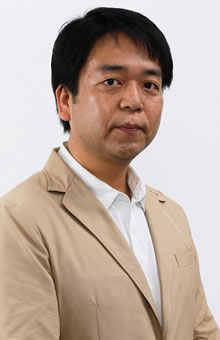Greetings
As the proverb says "Pour new wine into new wineskins", we need a novel concept for a new paradigm.

Ryuji Tamura, Area leader, Tokyo University of Science, Professor
In 1984, Shechtman et al. reported 5-fold rotational symmetry without translational symmetry in a Bragg reflection image of a rapidly-quenched Al-Mn alloy. Quasicrystals are now found in over 100 alloy systems, and may also exist in various systems other than alloys such as polymers, colloids, and mesoporous silica, and thus Shechtman was awarded the 2011 Nobel Prize in Chemistry. The discovery of quasicrystals, with high symmetry such as icosahedral symmetry impossible for three-dimensional periodic crystals, has brought about a paradigm shift in crystallography and has revolutionized the definition of crystals that has been accepted for hundreds of years.
The quasicrystal has a cross-sectional structure of a high-dimensional periodic crystal, with another extra "complementary space" required to describe the atomic structure. Depending on the slope of the cross-section, one can obtain either a quasicrystal or an approximant crystal in which the arrangements of atoms approximate the local atomic structures in quasicrystals. We define a group of substances that are uniformly described in a high-dimensional space including a complementary space, such as quasicrystals and approximant crystals, as "materials in a high-dimensional space (hyperspace)", that is, "hypermaterials". This project aims at establishing a new concept of substances, "hypermaterials", which is a high-level concept that includes the existing concept for substances, and also at creating a new theory that incorporates the concept of hypermaterial.
To create such a scientific principle, it is essential to establish a collaboration with researchers in various fields such as crystallography, condensed matter physics, organic/inorganic chemistry, material science, data science, and mathematics. We would like to welcome challenging proposals, especially from young researchers.
Overview
The discovery of quasicrystals, with high symmetry impossible for three-dimensional periodic crystals, has brought about a paradigm shift in crystallography and has overturned the definition of crystals that have been accepted for hundreds of years. The quasicrystal has a cross-sectional structure of a high-dimensional periodic crystal, and another extra space called "complementary space" is required to describe the atomic structure. This project aims at establishing a new concept of substances, "hypermaterial", which is a high-level concept that includes the existing concept for substances, and also at creating a new theory that incorporates the concept of hypermaterial.
In order to achieve the above purpose, this project will be conducted with four research groups.
The A01 group challenges to synthesize new metallic, semiconducting, ceramic, and polymer hypermaterials, partly based on the material compositions provided by the A03 group. In the A02 group, the static and dynamic structure of the newly synthesized hypermaterials are investigated by using X-ray, neutron beam, etc. In the A03 group, a database of hypermaterials is constructed, and the descriptors related to the stability of hypermaterials will be identified. Also, the descriptors related to the structure and physical properties of hypermaterials are searched in the real space as well as in the complementary space, and predictions of the compositions and physical properties of hypermaterials are performed. In the A04 group, the physical properties of the newly synthesized hypermaterials are measured, and the states of electrons, spins, phonons, etc. are investigated. Also, in cooperation with the A02 group, the physical quantities are mapped to the complementary space in order to elucidate the hidden orders, and their interpretation is performed.
Through active collaborative research among the four research groups, we will search for new physical properties and new phenomena, which cannot be obtained with conventional crystals, and will create new materials science based on the complementary space.
